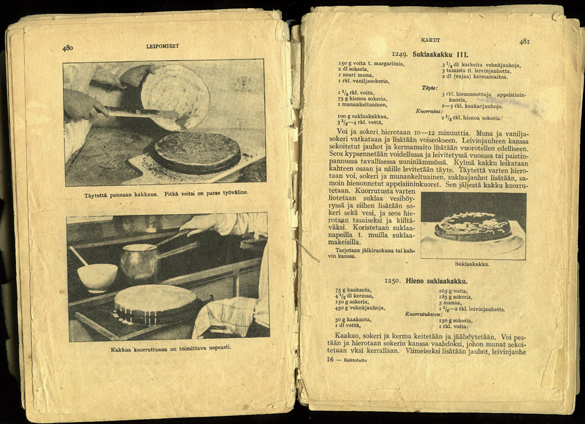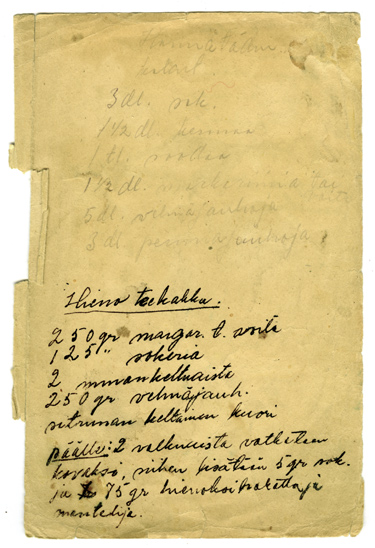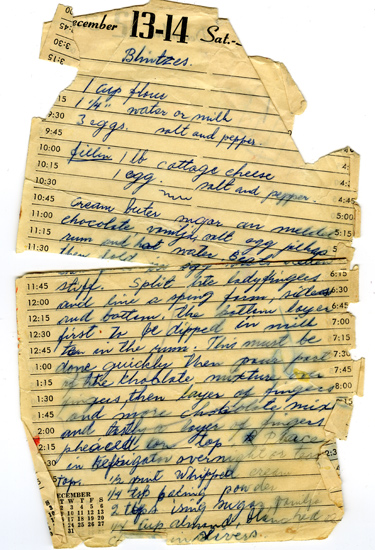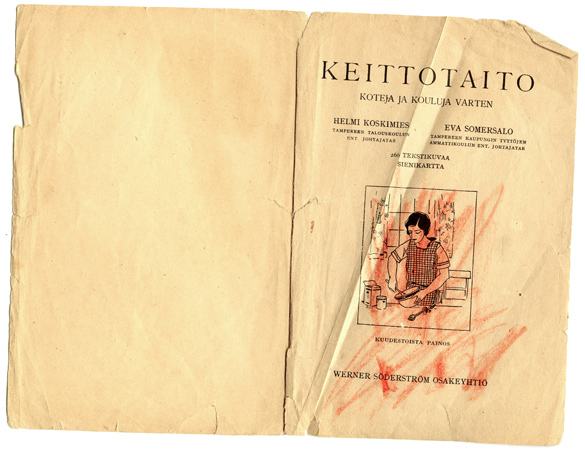a Finnish cookbook-2
a look inside my mother’s old cookbook:

some pages on cake making

a handwritten recipe on a blank page – a naughty habit of mine as well

many loose bits of paper inserted throughout, some with handwritten recipes and some clippings from newspapers – also my habit

traces of a child’s colouring with crayon – mine? my little brother’s?
Why do I find such beauty in disintegrating paper?
March 29, 2012 in Books, Finland, Estonia & Finno-Ugric, Found Objects, Home, Photoworks by Marja-Leena
Oooh, the handwritten pages are so attractive. I agree that the disintegration, the scuffed and torn edges, the old fashioned handwriting and numbers, and the typography of the diary,… they are all so seductive. It’s at the more sentimentally personal end of that phenomenon which leads us so often to hold ruins as more beautiful than whole buildings. Anyway, there’s a lot of potential here for you to mine visually.
I am struck by the quality of the handwriting. So beautiful.
And thus quite easy to read!
It’s sweet to see the insides of the old cookbook and remember when all the instructions involved hand mixing the ingredients rather than using a Kitchen Aide, a food processor, or (heaven help us) a bread making machine. I know they’re useful tools when cooking for a family but to me they often indicate that people feel they have more important things to do than to spend time together cooking and talking. I think a little wistfulness for times gone by may be part of the answer to your question.
Olga, you are right about us often finding ruins more beautiful than the whole. The sense of time and history must be part of it. Yet we don’t want our homes looking like they are going to ruin 🙂
rouchswalwe, thanks, they are not the best example of mother’s writing. I find it interesting that everyone of her generation wrote like that. Penmanship, and of a certain style, was pretty important in school back then it seems.
Susan, I had the same thoughts about those days without kitchen appliances. The recipes even give long times for stirring the cake batter, by hand of course. Time was slower back then it seems.
My grandmother had a wartime cookbook, which handled using of dandylion-roots and leaves, mushrooms, berries, grounded pine bark (?park) for part of bread flower, using different leaves for different spices and at the end: use of willow bark instead of aspirin.
She lived in Western Finland, Ostrobothnian country side, so she could use all the stuff. She had a small farm, 10 hectars grain fields and 40 of forest. Her oldest daughter stayed with her all her life.
As being is Western Finland also meant that mushrooms were not edible, in their opinion, until they have to use it. They did have animals, few cows, half a dozen chickens, some sheep (for wool), so farm would not need hardly nothing form outside. Flax was grown and wool was made into clothes. Only salt for potato soups was needed.
I was the oldest granddaughter, so I heard a lot of stories of finding this or that stuff. They could sell butter or cheese, but usually it was changed into something else, like nails, for instance.
I don’t have the book . It was left to the old house where my cousin lives. But he doesn’t want relatives there any more. The place is his.
We have recipes carefully written down from my anoppi, albeit in English, and one or two from her mother. Treasures…
Ripsa, thanks for your words about life in your grandmother’s day during the war, so very similar to my maternal grandmother’s life, also on a farm, in the Savo region in eastern Finland. I have not seen her cookbooks but I too remember the many stories my mother, the eldest, told me. Times were still hard after the war with food rationing, so my family living in town would be lucky to be able to get butter and eggs from the farm. That farm is owned by one of my uncles, though no longer farmed except for a garden for their own needs. We have visited several times, it is still a gathering place for the family…. and now I wish I could go visit again.
Black Pete, yes, they are treasures indeed, of family, roots and the immigrant story.
Do you think maybe with everything going digital, paper artifacts like this seem more valuable?
I notice that the measurements in your mother’s cookbook are metric. I was never able to master metrics in my cooking, and when I lived in Germany and Switzerland really could not follow recipes in German cookbooks for that reason. I counted on my Joy of Cooking.
Hattie, I think that may be part of it. Yet, here I am, digitally preserving these paper artifacts.
As for metric measurements, they are pretty common in Europe. All you need are a kitchen scale, metric measuring cups and spoons. Even though In Canada we’re supposed to be metric, it is a mixed bag of both, so I’m set up both ways. Weights of dry ingredients are actually much more accurate than volume, I’ve learned.
There are people who pay handsomely for such books now, being full of history and atmosphere and hand-written notes. Much nicer than a Kindle!
The older I get, the more embroiled in technology I become, the more I yearn to return to old ways and values!
Lovely bits of the past, Marja-Leena–
Maybe that last comment is a hope for beautifully bound books!
My husband was the only relative who wanted his grandmother’s recipes (in a box, jumbled), and I made a little book and preserved them. There are repeats, mostly hand-written on cards and scraps, and some newspaper clippings. She taught him how to cook, make pastry, make bread and homemade doughnuts, etc. Just opening up the book gives one a sharp sense of how different life was, and how important cooking was to a rural family.
Mouse, perhaps it is because of your work in technology that you (and many of us) crave and love the old. I don’t have any kind of eReader but I do spend an inordinate amount of time on this computer, including making art here, even so much that I don’t read books as much as I used to.
Marly, you are right, I love beautiful books. I’m reminded of some lovely leather spined books on Finnish art which I bought in a secondhand bookstore in Helsinki long ago.
What a lovely story about your husband and his grandmother. The book you made must bring back wonderful memories of the times he spent with her, and what a gift to have learned to cook and bake as a boy!
From all I heard about Marly’s husband’s skill in the kitchen when she stayed here in Wales with us last year, his grandmother would be mighty proud at what he learned from her.
Thank you for showing the inside of the Finnish recipe book Marja-Leena. It makes me feel slightly less ashamed of my own habit of writing in books!
Clive, I’d like to meet Marly (and you too) some day – such interesting folks one meets through this medium! As for writing in cookbooks, doesn’t everyone? I don’t usually do it in other books, though I think some of my university books may have some marks made during lectures.
It is a gift to see beauty in ordinary, little things and thank you for sharing that! Lovely post, very nostalgic! have a Happy Easter, Marja-Leena
Leena, kiitos, thank you! I can imagine how nostalgic this old cookbook would be for another Finn. Happy Easter to you too.